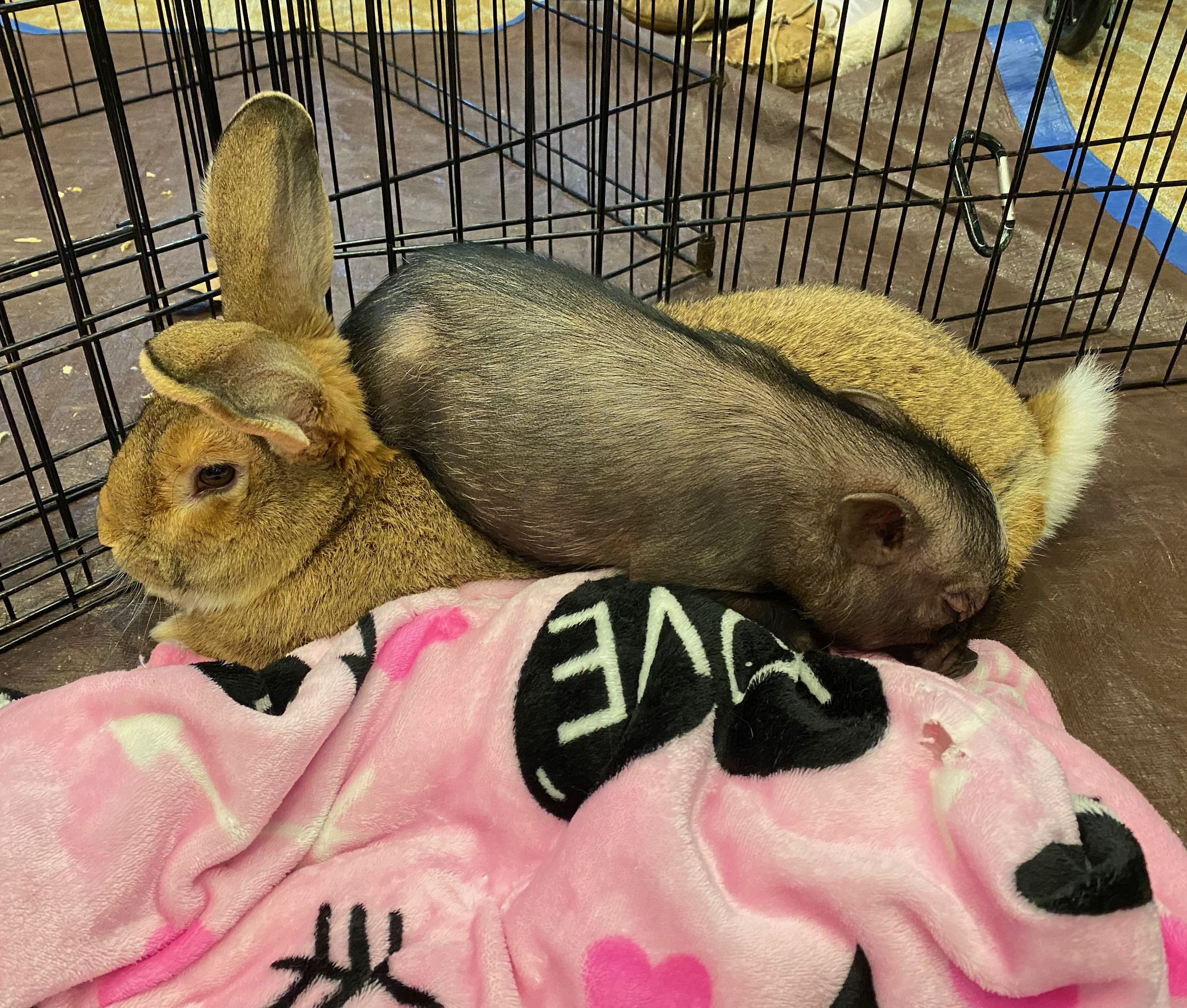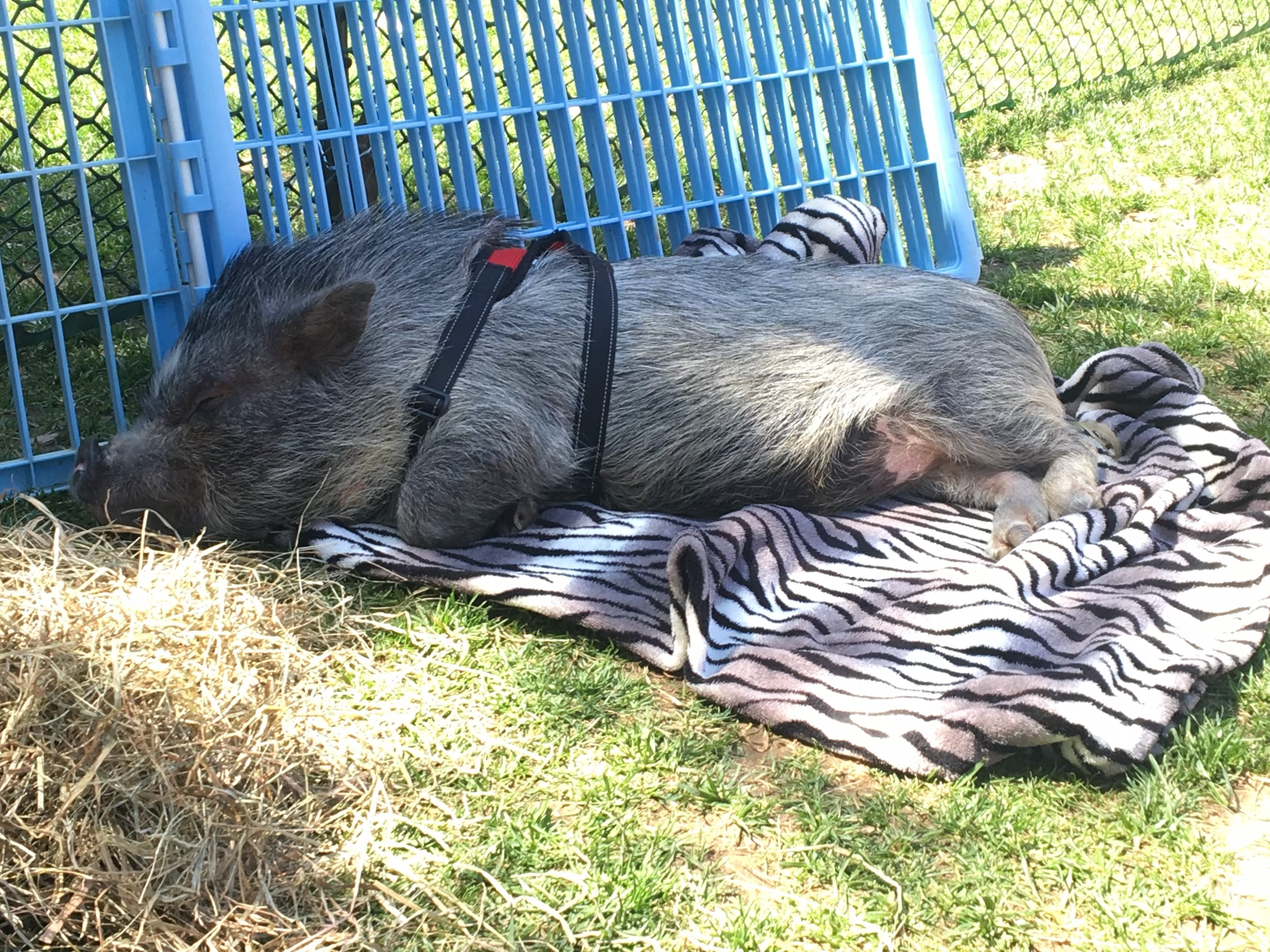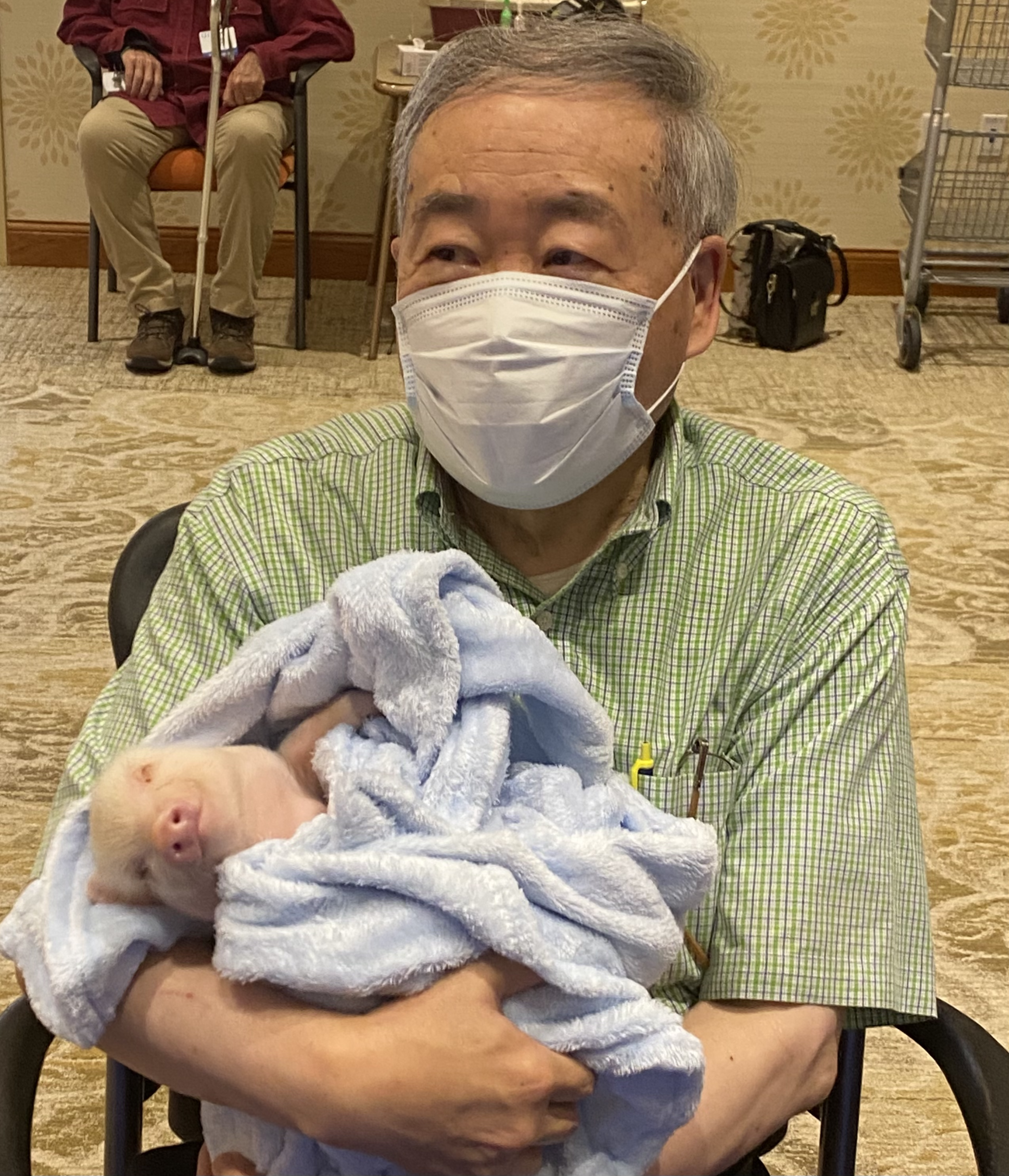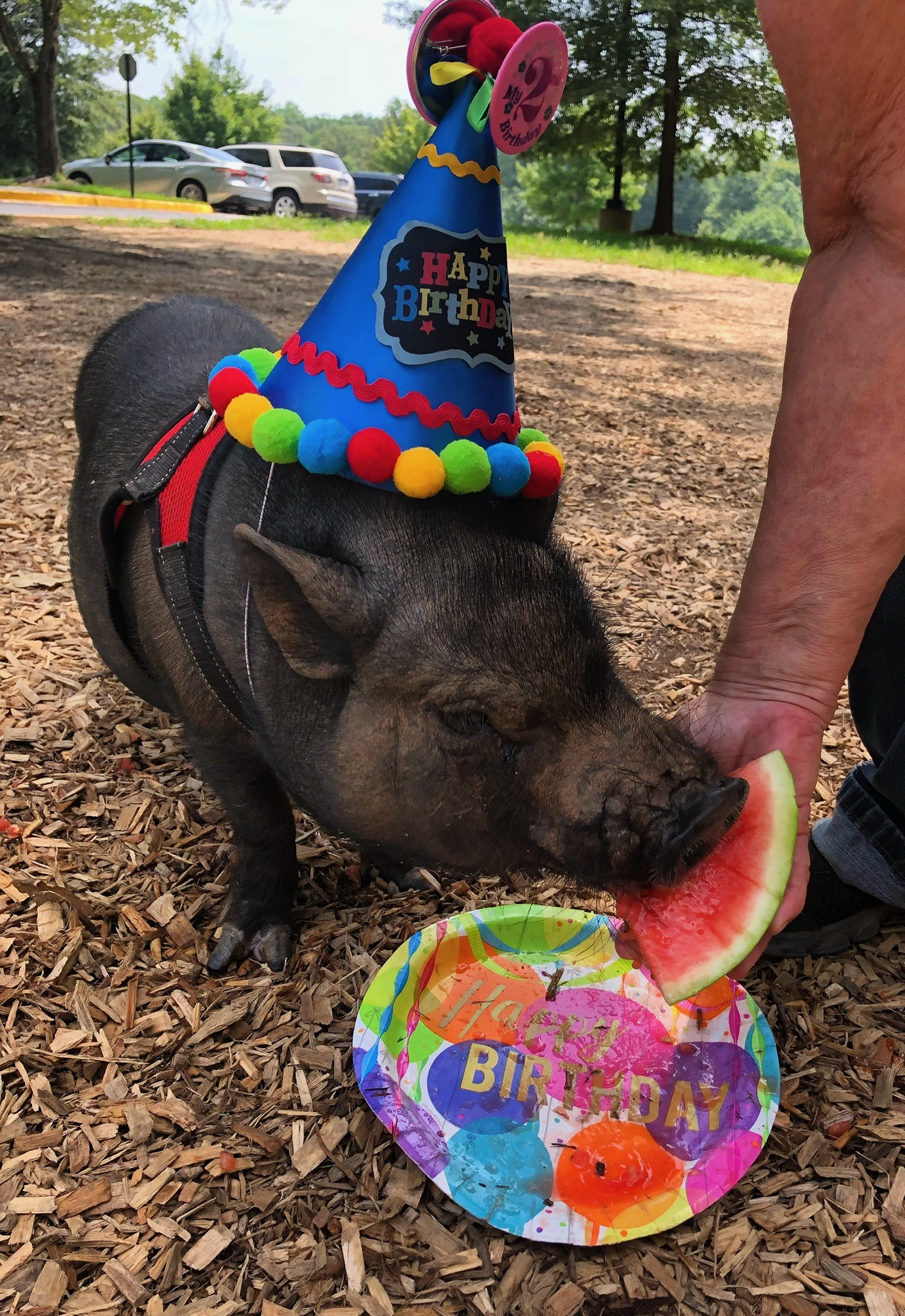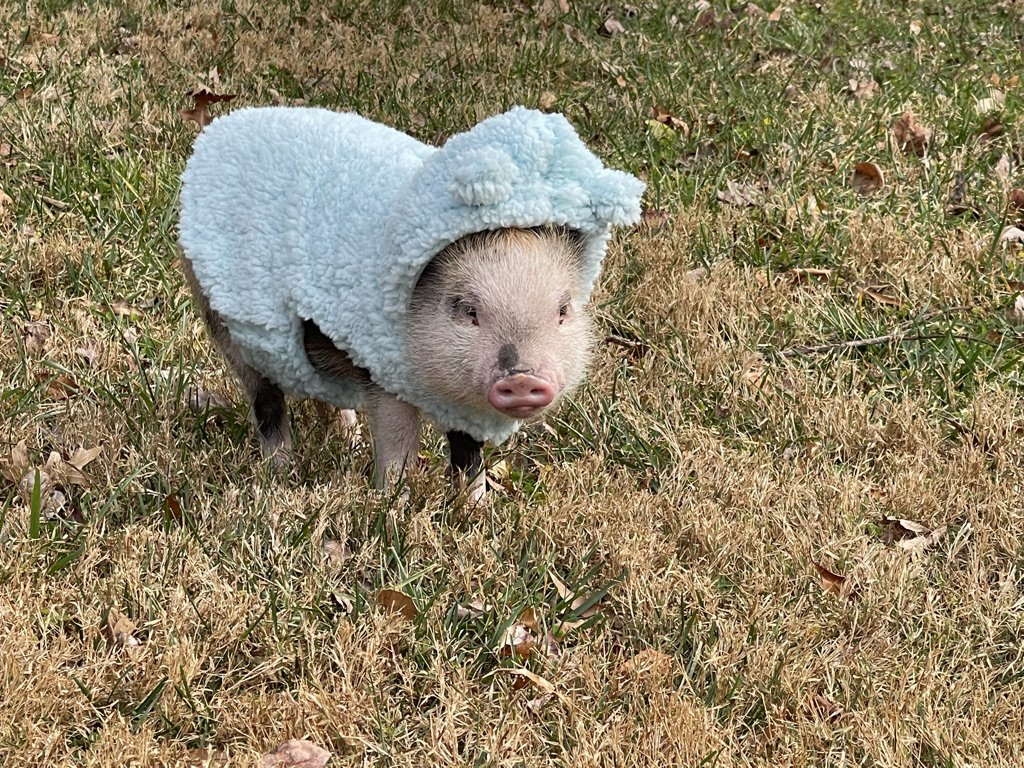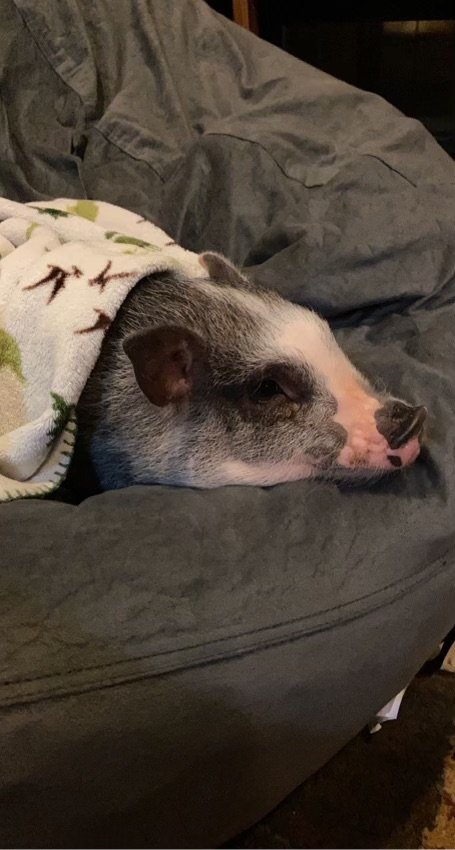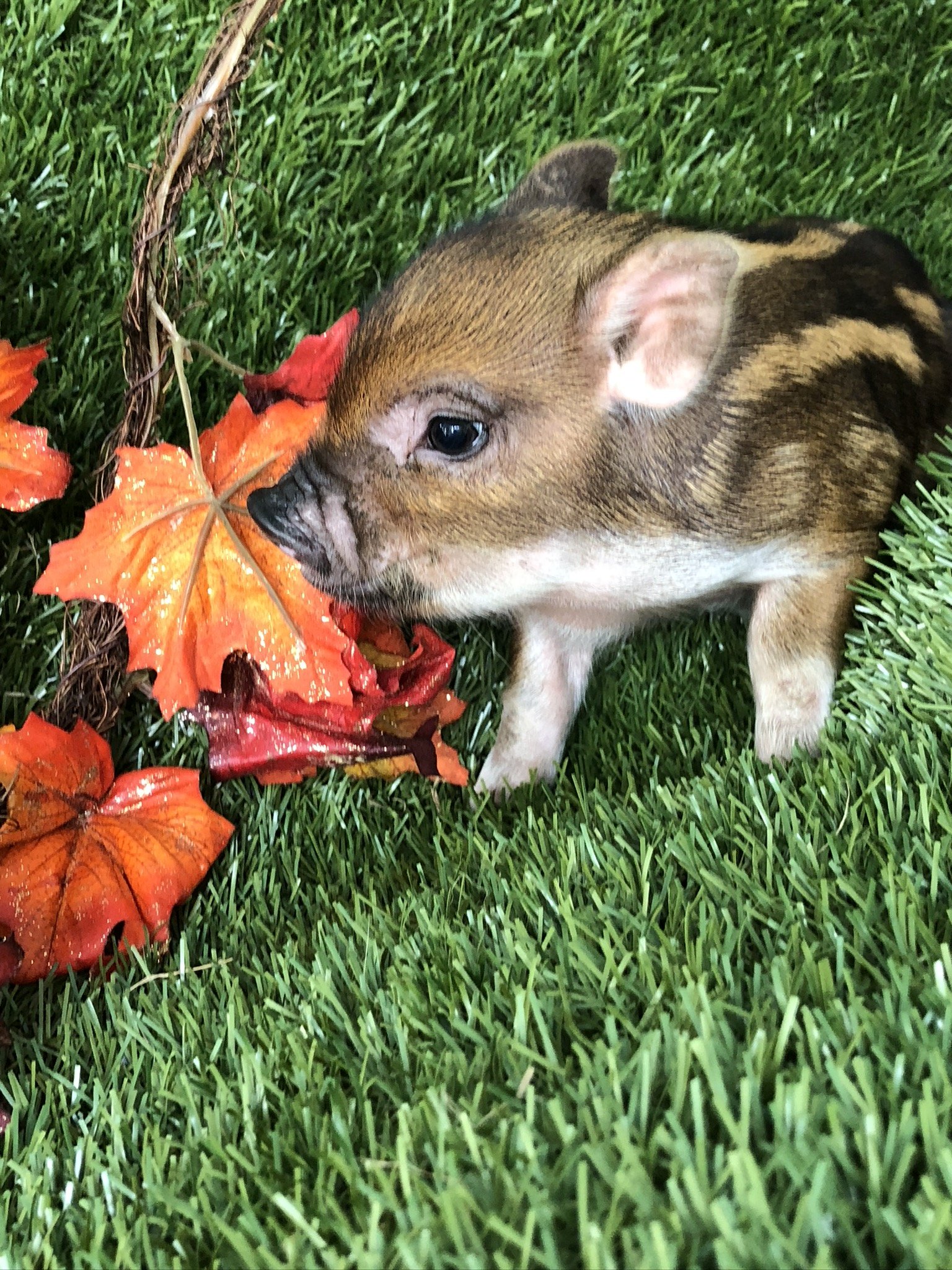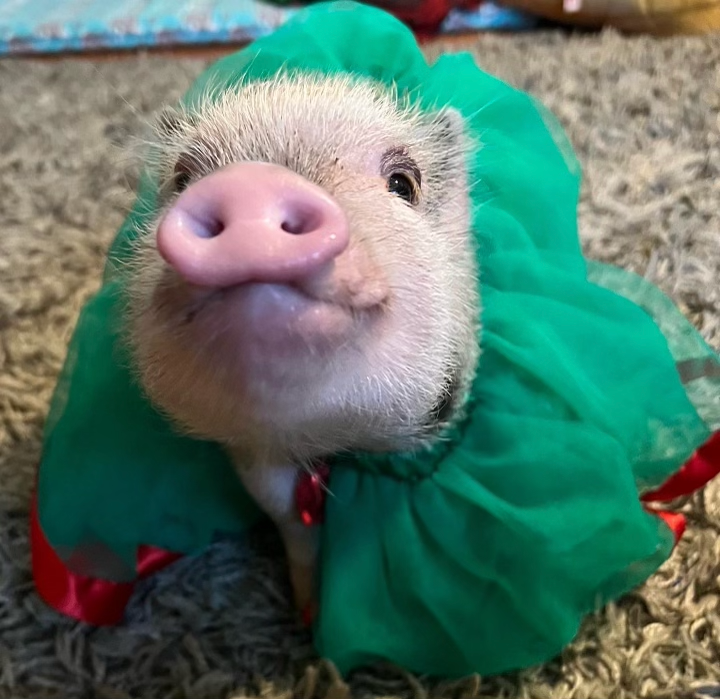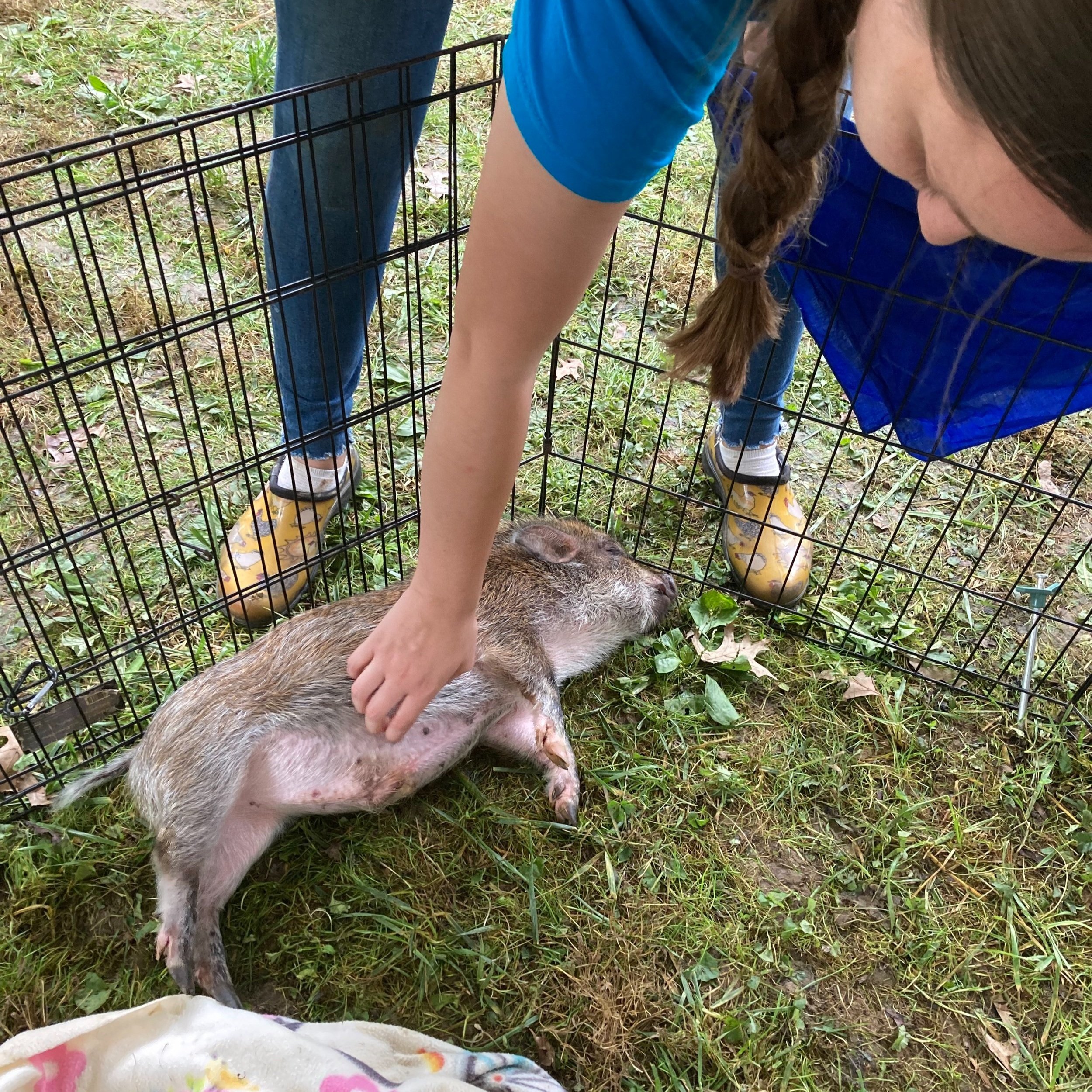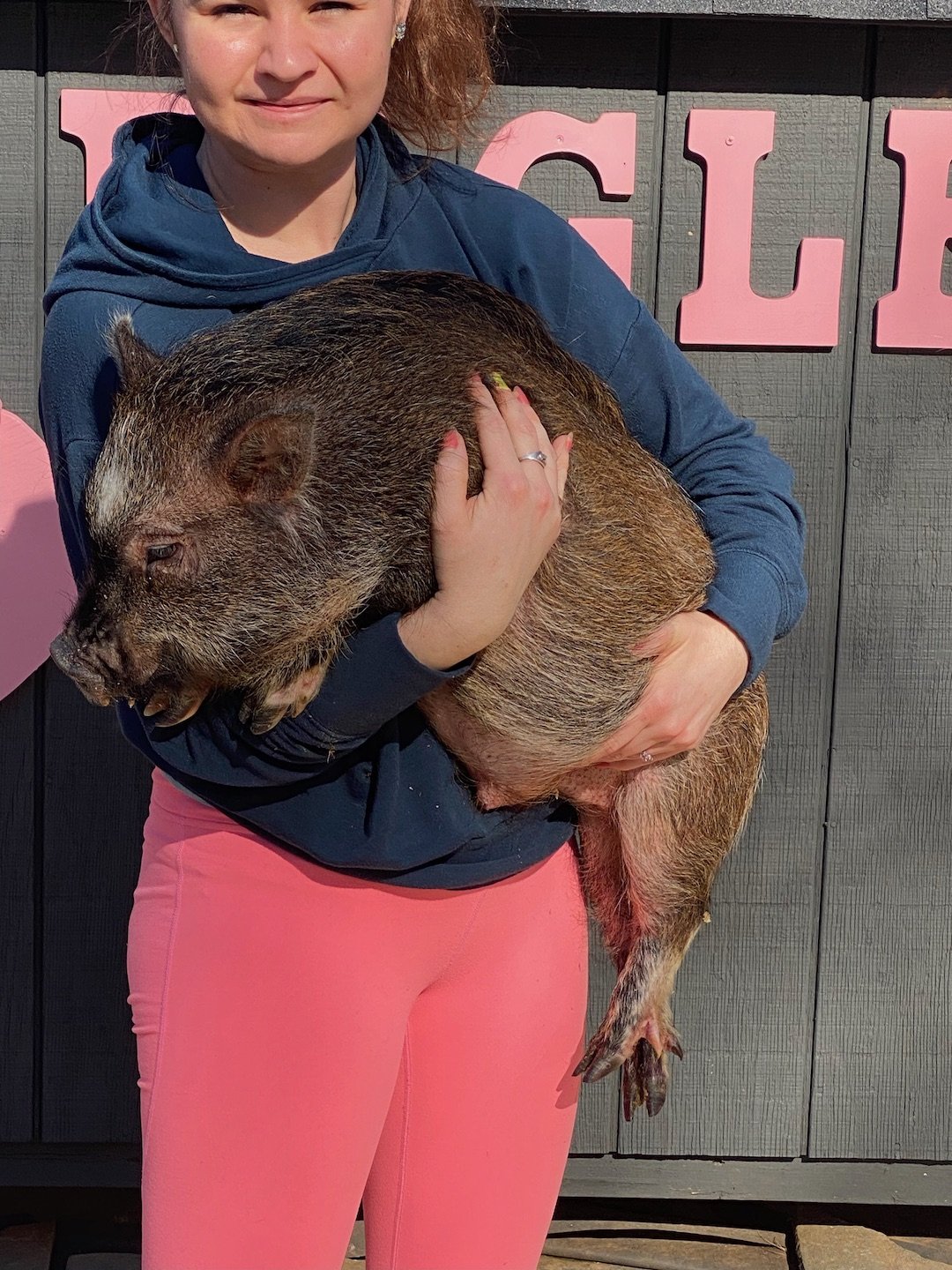Mini Pigs - The Right Pet for You?
Welcome to Squeals on Wheels, where we share the enchanting journey of mini pigs from their early days as adorable piglets to their growth into beloved adult pets. Explore our collection of photos and videos showcasing the development of our pigs, along with essential information on adoption, care FAQs, and why mini pigs make wonderful additions to families. Whether you're considering adopting or simply curious about these intelligent animals, join us in discovering the charm and personality of mini pigs at Squeals on Wheels.
IS A MINI PIG THE RIGHT PET FOR YOU?
BABY PIGS ARE ADORABLE, BUT HOW BIG WILL THEY BE?
They are adorable and a wonderful pet if raised correctly! But there are a lot of things to consider when thinking about getting any animal as a pet, so we’re outlining why you want to add a mini pig to your family and why you might think twice.
The sizes and photos of our parent pigs are posted on our website and measurements are updated on an annual basis. Miniature pigs are very dense and heavy animals compared to their height and length. Pigs look half the size of their weight in body composition compared to dogs, meaning a 100 pound mini pig can look like a 50 pound dog. It's important not to get hung up on the weight of a pig because pigs have a much higher density of weight (approximately three times) compared to dogs and other animals - they are a very 'thick' animal. A 50 lb mini pig is actually quite small and often times only 13-16 inches tall and very small compared to their ancestors. If the weight of an animal is a huge factor, then maybe a guinea pig is a better choice :)
Pigs are not considered fully mature in size until approximately 5 years, though their bone growth plates close at age 3 1/2 based on historical pig x-rays. However, the primary growth period of a mini pig is within the first two years of their life.
When looking for a miniature pig, it is best to have an ideal height and length in mind, as opposed to ideal weight. Our piggies can definitely fit into a teacup when they are born…but they will grow! The term teacup pig is definitely a misnomer. They are also called mini pigs, micro pigs, and more!
Your piglet's full-grown height and length will be in the range of the parent's size, usually. What you feed your piggy plays a vital role in the maintenance of a healthy pet pig. Although the bone structure of litter-mates is similar, what they are fed definitely influences the size of your mini pig. Check out the sizes of our parents pigs for an idea of the size of our babies our babies will grow into. They are very comparable is size to an English Bulldog - similar body composition, with very dense midsections and short legs.
TIMELINE OF PIG GROWTH (READ CAPTIONS FOR DETAILS!)
Three day old baby born to Starlight and Harry Half Pint! This is where the term “teacup pig” comes from, but as you can see from the next pictures, they will grow!
Kerry holding a seven week old baby born to Reba and Harry Half Pint
Noelle holding Mocha, a little over a year old in the picture! He is about 75% grown since pigs do the majority of growth in their first year.
HOW TRAINABLE ARE MINI PIGS? (See videos above)
Mini Pigs are very trainable, as they are very very intelligent! Pigs are like 3-year-old children - intelligent, curious, mischievous and sometimes manipulative. They are sensitive creatures that can be playful, and even humorous. In the intelligence scale, they are only two species away from the intelligence of humans! Only the monkey/ape family and the dolphin/whale families are more intelligent. It’s very important to give your piggy lots of stimulation and trick training to keep their minds active.
ARE PEOPLE ALLERGIC TO PIGS LIKE CATS AND DOGS?
Mini pigs don’t have coats, so they don’t shed dander like cats and dogs. That means they tend not to aggravate allergies in people with pet allergies
They are clean, generally non-allergenic, odor-free, flea-free, charming and inexpensive to feed. Pigs are social, bonding easily with humans. They’ll readily roll over for a tummy rub, as well as snuggle with you. They don’t bark, prowl the streets or spread rabies. Compared with dog droppings, mild smelling “pig berries” are a breeze to clean up. Mini pigs are motivated by food, so treat-based positive reinforcement training is best. You can take them for walks, and you can usually use products made for dogs, including leads, bowls and adorable little jackets and outfits.
BONDING WITH A PIGGY
If you are looking for a pet who will be very attached and bonded to you, piggies are an awesome option. Mini piggies are "special" animals and parents who take the time to understand the psychology of piggies bond very closely with their piggies. Many pet parents sleep with their pigs, travel with their oinkers, dress them in costumes and share every aspect of their lives with their piggy companions. Piggies love to have their tummies scratched, and to snuggle with their owners.
Pigs don’t have sweat glands, so they don’t generate their own funky smell. The males only begin to stink because when they mature they develop scent glands that smell awful. Neutered males and female pigs don’t develop these glands, so they never really smell bad in and of themselves.
Pigs are very sociable, and they get on well with other household pets, especially if they are introduced to other animals at a younger age.
They love to be in blankets, and not just during winter holidays. They love their blankets all the time. Digging around in blankets helps alleviate their rooting instinct, and when they do that, you’ll have a pig in a blanket.
WHY YOU’LL WANT TO THINK TWICE
While pigs are highly trainable and can learn at a faster rate than dogs, pig behavior is vastly different from dog behavior. As eager as a dog can be to please his master, a pig’s respect, trust and cooperation must be earned.
Piggies are herd animals with a strong pecking order. If they are spoiled, they often become territorial, and aggressive towards humans, especially house guests. The pigs have an instinctual urge to be "Top Hog," and defend their turf. Pigs with lots of subtle, daily discipline and boundaries in the home, do not exhibit this phenomena. The oinkers must be taught the word "NO" and to respect humans. The psychology of piggies and how to work with them is discussed during the one hour educational class we provide when you pick up your piggy. New owners also receive educational handouts on this and other important piggy topics.
Piggies enjoy time outdoors, in a fenced yard (secure from hostile dogs) and/or taken on daily walks. This cuts down on household territorialism, and gives the pig something to do. Pigs root, although this can be somewhat curtailed. They rarely get fleas, but do get mange, which is easily treatable. All in all, pigs have the potential to be the BEST pet, or the very WORST pet. It really depends upon the expectations and efforts of the owners.
If you are getting a pig for a teenager, ask yourself if you are prepared to take care of the pig when your child gets busy with high school activities. Who will take care of the pig when your child leaves for college or first job? Proceed with caution when getting a pig for young children. Children of any age are frequently intrigued with the idea of getting a pet pig, but quickly the responsibility of daily care falls in the hands of parents. Are you prepared for that?
You need to know the legalities of owning a mini pig in your area. They can be considered livestock or exotic animals and not always allowed in neighborhoods.
Standard procedures for cats and dogs, like spaying and neutering, need to be done by a specialist on a mini pig. This is important because you have to spay and neuter pigs (all or our male pigs are neutered, and our females have the spay surgery). If not spayed or neutered, piggies can become unmanageable.
Pigs need access to water, as they love to play in it. If you get a piglet, get a little shallow kiddy pool.
Pigs don’t have anything that regulates their hunger, so they are always hungry. They can learn how to open fridges and cabinets to get to food so it's best not to give them food from a cupboard - they will remember which cupboard they need to open!
THOSE ARE THE PROS AND CONS OF HAVING A MINI PIG!
Some people think they would be too much hassle and other families couldn’t imagine their lives without their pigs. Like any animal, you have to weigh the benefits and the disadvantages and make an informed decision about whether or not you can handle the responsibility and whether or not the animal will be happy with the life you can give them. It’s not a decision to make lightly, because you don’t want to put a pig in an animal rescue just for being itself!
Our pigs have found loving, forever homes in Maryland, Virginia, North Carolina, South Carolina, West Virginia, Maine, Vermont, New Hampshire, Massachusetts, New York, Connecticut, Pennsylvania, Delaware, Georgia, Ohio, Iowa and Tennessee! We have also had people fly to Baltimore Washington International airport, rent a car, pick up a piggy and drive back to Colorado and Texas! Why? Because we are up front with the sizes of our parents and the expected babies’ sizes and include pictures of our staff holding adults and babies.
Mini piglets are known by many terms. Regardless of the name that is used, please make sure you see the parent pigs (pictures and videos with the handlers are great)! These pigs may be called by the following descriptive terms: miniature teacup pigs, mini pigs, teacup pigs, micro pigs, micro mini pigs, micro mini teacup pigs, American mini pigs, etc. On our website, you can see pictures of our staff holding parents and babies - This is one of the ways we stay transparent and give you an idea of how big your pig will be compared to humans!
Mini pigs - from babies to adults!
Check out media of the progression of our pigs’ growth and additional information below
We take lots of pictures and videos while we have babies for their first two months of life and lots of families send us updates throughout the years. We love to share these pictures with prospective pig parents so you can see the development of piglets! They’re cute when they’re little, but just like puppies and kittens, they do grow up. When thinking about adopting a pig, make sure you want to be a pet parent to an adult pig, not just a baby pig.
Tulip’s Journey!
Tulip is a beautiful spotted piggy born to Starlight and Harry Half Pint. We are so grateful to her family for sending us pictures, videos, and updates!
She was born Sept. 28th, 2021! The last video below is from Feb. 2023, age 1.5.
Mocha’s Journey
Mocha is one of our boars, whom we have had since he was a baby! He has gorgeous faint stripes and a unique red and silver color with a white blaze. Check out the video of him (June 2021) rooting in his blanket plus a recent video of him getting pets (June 2023).
More media that we have taken or families have sent to us!
Clover (video left) celebrating her birthday!
Check out the video of Clover to the left to watch her working on tricks at a few months old. Look how far she’s come as she celebrates her 1 year birthday!
Clover learning lots of tricks at her forever home!
A few of our babies (about 8 weeks old) enjoying some play time!
All of our mini pigs are well-socialized before adoption! They travel with our petting zoo to events and learn proper behavior from their siblings and moms.
